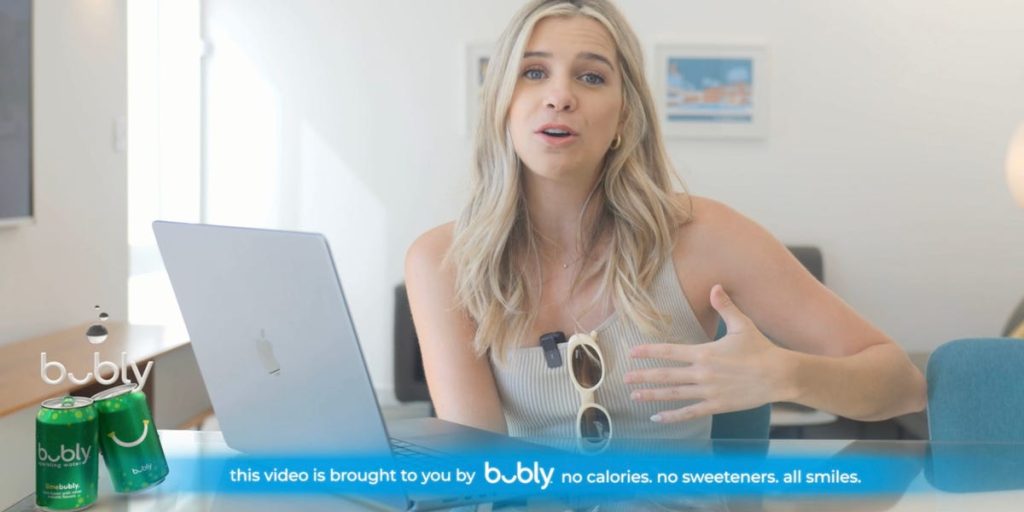In an October YouTube video, lifestyle creator Shelby Church talks about quitting Airbnb. Two minutes into the video, an animation of two seltzer cans appears on screen with the text: “This video is brought to you by Bubly.”
This new ad structure that’s being incorporated into YouTube and TikTok videos could help generate passive revenue for creators.
The company behind the advertisement, Rembrand, wanted to embed brands into videos in a way that supports creators but doesn’t annoy their audiences by interrupting the content.
“We realized that there’s this problem with interruptive advertising,” Rembrand CMO Cory Treffiletti told Business Insider. “Everybody understands that the content has to be supported by advertising, but almost universally, no one wants it interrupted by the advertising.”
The Rembrand team turned to product placement to do that. Rembrand uses generative AI to create and place the ad into a video.
At the same time, creators like Church, who has 1.8 million subscribers, can make extra money from their videos with little to no work. Creators are paid on a revenue-share basis. They earn a percentage of the revenue that Rembrand brings in from the advertiser, which typically pays a fixed CPM (or cost per 1,000 views) rate between $15 and $20. That’s similar to the model for Google’s AdSense program for the standard ads that air during a YouTube video. Rembrand calculates the creator’s rate based on the number of views the creator typically gets.
Creators can sign up for Rembrand through the company’s website and start making money after they are matched with a brand. The startup works with brands including Bubly, investing firm Charles Schwab, and hair-care brand Garnier.
Rembrand also has access to about 1,000 creators with between 100,000 and 3 million subscribers through its partnered agencies, Treffiletti said. There are no specific audience requirements, he said, but on average, a typical Rembrand campaign is focused on creators with a minimum of 35,000 subscribers.
Rembrand, which has about 50 employees, raised $8 million in a 2023 seed round from venture-capital firm Greycroft and UTA Ventures, a VC arm of United Talent Agency.
Rembrand’s silent animations could help establish a new revenue stream for content creators. Product placement — a staple in other forms of video entertainment like TV and film — isn’t a major revenue stream for creators, who typically rely on branded content, traditional advertisements, and affiliate marketing to earn money from their videos. In creator videos, product placement has mainly appeared in the background of show-like setups, like video podcasts.
Rembrand’s AI tool creates and places the ad
Rembrand aims to use AI to make product placement easier for brands and creators.
Traditional product placement typically takes brands a long time to create because it requires custom messaging to be integrated into the right content. Rembrand wants to speed up the process.
Its AI generates, renders, and inserts a three-dimensional branded object, like a shampoo bottle, into a video. The tool works with popular video-editing platforms, including Final Cut Pro and Adobe Premiere.
It identifies where to place the product within the video during post-production. Both the advertiser and creator have to approve the video and can change where the animation appears.
“We do make sure that all the content is brand-safe and that no competitive brands are going to be in the video,” Treffiletti said.
Rembrand’s dashboard allows creators and advertisers to access the company’s technology and make deals, and creators can track their earnings. Advertisers can also develop a brief outlining a campaign’s audience, budget, and timing and share it with Rembrand for creator recommendations.
Treffiletti estimated that about 70% of Rembrand’s campaigns exist on YouTube, and 30% are on TikTok. On average, the placements run for about 2 minutes and 13 seconds.
“We’ve been able to increase the time a brand is on screen, and that works great on YouTube,” he said.
Up until now, Rembrand has required creators to work directly with a rep to run these kinds of campaigns. Treffiletti said the company is expanding with a self-service version of its tool, allowing any creator to make and insert a virtual product or brand animation within their videos and get paid for it.
While it’s too early to tell how this ad strategy will compete, the company is betting on a better viewing experience that the audience won’t overlook or outright skip.
“We’re excited to create this entirely new placement opportunity for brands because we think there’s a space alongside pre-roll and post-role video ads,” he said. “We’re not saying that those are going away, and we’re not saying we’re going to kill anything, but we do think that the interruptive component inside the content will probably start to fade away.”
Read the full article here




